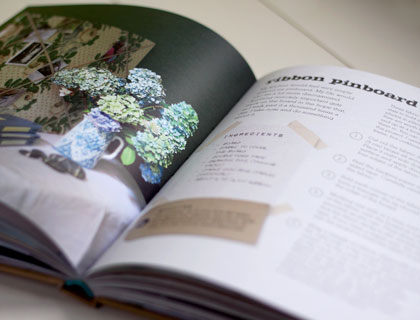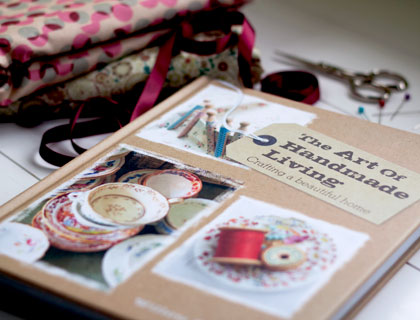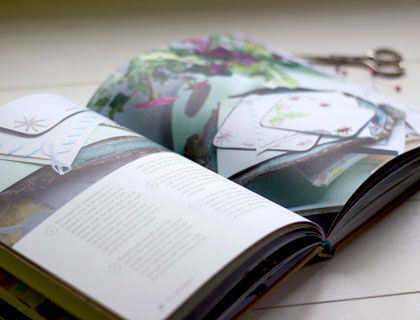The Art of Handmade Living: Crafting a beautiful home
By Willow Crossley · Reviewed by Katy McRae
Things got off to a good start with this book, when I read in the introduction that Willow has a son called Wolf. I also have a son called Wolf(gang), so I liked her immediately. However, I endeavoured not to let her good taste in naming her offspring bias me as I progressed through the rest of her book. I tried to be impartial and, to be honest, it wasn’t hard as having sons with the same name is pretty much where our similarities end.
It’s fair to say that Willow’s aesthetic is not minimalist. In her own words, “I don’t really make things that anyone might need, just things that enhance your life (or at least the way it looks).” She appears to be on a one-woman mission to decorate the bejesus out of everything. Nothing is safe or sacred. House pegs are zhushed up with washi paper, coat hangers get a fabric face-lift and no lampshade is complete if it isn’t festooned with ribbon and finished off with pom-pom trim.
I’m all for adding personal touches to things but Willow can be, at times, a bit excessive in her determination to beautify everything she touches. Case in point – ‘decorative sticks’. To clarify, these are sticks that have thread wrapped around them. As Willow herself acknowledges, “They don’t do anything or have any secret purpose. They are purely decorative.”
Realistically, I don’t think decorative sticks would have a place in my home but I do have a respect for the way Willow is determined to transform the mundane, the functional and the downright useless into things of beauty. She is a firm believer that functionality does not have to be at the expense of form.

The book is divided into four chapters – ‘To Decorate’, ‘To Hang’, ‘To Use’ and ‘To Nest’ – though really they are all ‘to decorate’. In the introduction she makes a point of saying that you don’t need to be a technical whiz or expert stitcher to be able to make the projects in the book, and she isn’t kidding. Some of these projects really are super, super simple. For example, putting a ribbon band on a hat (though she does include some handy hints on how to hide the join) or sticking felt to the back of an old tile to make a heatproof kitchen coaster. There are, however, some slightly more involved projects, particularly in the ‘To Hang’ section, which have real wow factor.
As well as being straightforward, these projects don’t require any great financial outlay (sticks, anyone?). It’s all about using what you have to hand, or what you can rummage up from nature or the local flea market.
As you would expect from a woman determined to make things beautiful, this is a beautifully presented book with photography that showcases the projects to best effect. It’s an easy read and the instructions are very simple – almost to a fault. At times I felt some of the steps go without saying. For example, you must leave the glue to dry completely before hanging anything from the fabric-covered coat hanger. Bit of a no-brainer, that one.
The Art of Handmade Living is the ideal present for that friend who is ‘getting into craft’. It’s also a lovely addition to the bookshelves of those hardened crafters who are looking for some fresh inspiration on how to make the world a more beautiful place, one fabric-covered notebook at a time.
Katy McRae likes formica tables, sharp scissors, fabric (especially felt), strong-smelling solvents and words. She also likes to make stuff. She’s not a fan of the colours peppermint and royal blue.




I love your review of my book! Thank you – hope you enjoyed it!
“She appears to be on a one-woman mission to decorate the bejesus out of everything.” is the best line I have read in a book review ever.
The above sounds like a fair, and humorous, review. I enjoyed reading it. Thank you, Katy!